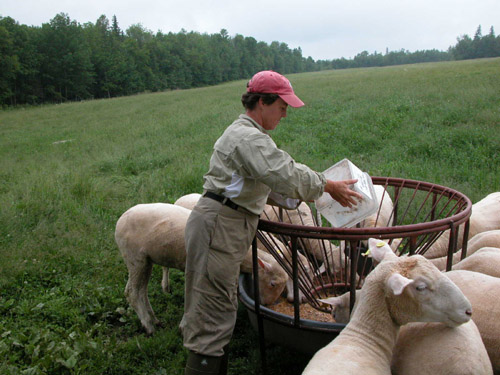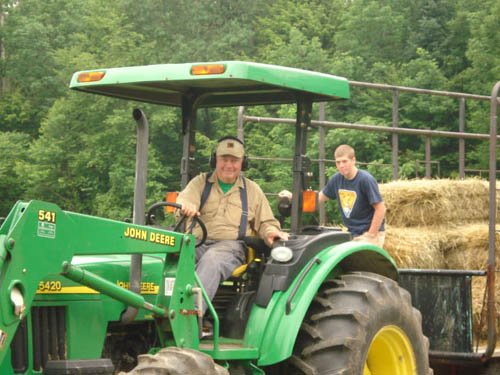Check Out
Down on the Farm in Maine
Interview with Mary and Bob Burr

The picturesque Blue Ribbon Farm in central
RailRiders Adventure Clothing recently spoke with Mary after she sent us the most delightful email. "My husband and I have been long-time fans of your apparel. We've been wearing your outdoor clothing daily on our farm, whether it is in the forests cutting firewood, working the sheep, making hay, or kayaking and canoeing
Q. What brought you from
Mary Burr: It was the love of a man that brought me here. I met my husband Bob of thirty-five years in
Q: What was it like growing up in
MB: I had the best of three worlds; the city, the ocean and the country. I was born and raised in the city of

Q: Was it an easy adjustment moving to
MB: Out-of-staters feel they have a hard time with acceptance if they aren't third generation or more. Bob's family goes back into the mid-1800's in
Q: Describe an average day on your farm.
MB: Our mornings always begin with livestock chores, regardless of the weather or time of year. The sheep are fed and watered and the laying hens are given the previous evening's fruit and vegetable table scraps--peeled potatoes, carrots, apples--after checking their self feeders and waterers. In the spring, we are busy with tending to the sheep needs of hoof trimming, shearing, parasite control and breeding. Our ewes give birth-- called lambing-- in the fall as opposed to the spring as most sheep do. We have

The vegetable garden is planted in stages during the spring depending on the warmth of the soil. We plant our cool weather crops-- lettuce mixes, peas, green onions, spinach, carrots-- early and continue planting as the soil allows. In May, we turn to getting the haying equipment ready for the season. Hay is our largest commodity produced from the farm. We grow 100 acres producing hay silage, dry square bales and round large bales. We cut all our fields twice -- a first crop and a second crop. The second crop is the best where there is a higher protein content to the grass. It's a challenge to get the first crop off in a timely manner to allow enough time for a good second crop. Here in
With hay making our main priority during the summer, any spare moments get taken up with weeding the vegetable gardens and managing the bee hives. We extract honey during the middle of the summer and that allows the bees time to fill their chambers with honey for themselves.
Come late fall and winter, we are into the woods. We are a certified tree farm and we utilize best management practices in our woods and harvest sustainably. We sell a variety of forest products: firewood, saw logs, pulp wood and occasionally custom sawn lumber. We manage our woodlots for both softwood and hardwood. Our softwoods are primarily eastern white pine, white spruce and balsam fir. Our hardwoods are ash, oak, maple, white and yellow birch. There aren't too many days we aren't able to work in the woods. We have a recreation cabin in the forest with a small stove where we warm up at lunch time and end the day; it's a cozy place to discuss our day's efforts.
Q. What are the differences between a sheep farm like yours and those in
MB: Size! Our flock at present is down to twenty-five ewes; we usually run around forty-five breeders. The flock is back in the growing stage. We have National Champion lineage and the young ewes on the farm are all from our National Champion Ram. The farm is always working on bettering the genetic pool. We sold half the flock last summer to a number of small lamb growers; some in
Q. What is your prized National Champion Ram like?
MB:."Big Deal" is a big boy on any sheep scale. At the height of his show career he weighed 365 pounds. You definitely want to have good control of a ram at that size and weight. He's actually a pretty nice guy, and feels most content when he's with his girls. What guy wouldn't want his own harem!
Q: Is there a typical personality for sheep?
MB: They each have an individual personality that is noticeable when spending time with them. Sheep are really nice to be around because they have a calming quality. They are very sociable and curious. If we weren't around them as much as we are, they'd probably be mad-hatters as they have a very strong herding instinct (protection from predators), but since they trust Bob and me, they vie for our attention. They almost get comatose standing there being patted. Any animal that is handled calmly and frequently, enjoys human contact. We find them very relaxing to be around. It gives us a chance twice a day to survey their condition and health and also a moment to enjoy the surroundings of their environment. They live in idyllic surroundings-- an old apple orchard surrounded by stone walls with a view of the mountains. Of course, most of them have names which suit their personalities. For example, 'Queen' is the leader of the flock and the oldest. She is a dear old girl and we just love her. Queen will be retired after her next lambing. She has produced well for us and has earned her retirement. 'Moneypenny' produced an ewe lamb that sold for $3,750. 'Snow' was very white at birth.
Q: Describe the output of a sheep - in terms of lambs and wool production - and what happens to them when they get old?
MB: A sheep generally has a production lifespan of 10 to 12 years, if they are well cared for. If it is a wool breed, they are sheared once or twice a year depending again on their breed. Some sheep produce such a long fiber they have to be shorn twice a year. A wool breed will yield 8 to 12 pounds of useable fleece annually, and will lamb once a year. Again depending on the breed, ewes will lamb in the spring and produce an annual crop of lambs of either singles, twins or multiple births. Their lambs will be used for replacements primarily for wool; meat is a secondary focus. The main focus of wool breeds is the quality of their fleece in comparison to the meat breeds, The meat breeds sacrifice the fleece (5 to 8 pounds) to produce a choice grade of meat lamb. In each case, an ewe will produce lambs for that 10 to 12 years of production, and in most cases, she will be culled from the herd when she is no longer productive. On our farm, an ewe that produces well for us, meaning, she produces mostly twins, is a good mother and milks well, will be retired to the pasture for the rest of her life. If the ewe doesn't have a good mothering ability, constantly produces single lambs or doesn't meet the breed standard of excellence that we strive for, she will be shipped for meat. I do want to emphasize, however, that farming links the reality of meat on the table to the animal in the field. Farmers take responsibility for what we eat. From our point of view, we provide our ewes and their offspring with the best lives they could have up until slaughter. We personally truck the sheep to the slaughter house so there is minimum stress on the animal. It's one of the harder aspects of farming, but a necessary one.

Q: Who helps you around the farm? And over the years?
MB: Bob was the President and CEO of Pride Manufacturing, the largest producer of golf tees in the world; they are also the manufacturer of ‘Softspikes' – golf shoe cleats. He worked on the farm weekends and vacations and during the hay harvest season, if he wasn't overseas or traveling for the company, he'd work evenings after his daytime job. With Bob working a full-time career I ran the farm. That has been my job for the past 30 years which I think is the best job in the world. During the busy summer months, we employed one or two of our town's youth. (Mercer is a rural town consisting of approximately 600 people in central
Q: What do you like best about owning your own farm?
MB: We both love working outdoors and living sustainably. We get to see what is happening in nature daily. We see the winter dissolve into spring and the leaves unfurl revealing a rich lime green that matures into a deeper shade of green. We can literally see the grass grow on a daily basis and all the wildflowers that blossom according to their season. Every day is just brilliant. Equally satisfying is the ability to grow our own food. It is very rewarding at the end of the day to know that what we have produced is for ourselves and to share with others. We always review the day in the evening over a glass of wine and a good meal. We also set goals annually as well as a five-year plan. We create a list every week according to the season for farm or forest activities that need completion. It gives us a sense of satisfaction to see items checked off as completed. We are both quite orderly and perhaps fussy about how things are done, so working for ourselves gives us the freedom to use our own skills to their best advantage.
Q: What do you see as the future of the family-owned farm in
MB: We both feel optimistic about the family-owned farm. It's a good time to be a farmer at long last. With more people paying attention to where their food is grown and how it is grown, there is a strong sense of 'buying local' from farmers in one's community. It seems that we are hearing more alerts on contaminated foods grown or raised overseas and sometimes here in the

Q: Any new changes in store for your farm?
MB: Here on Blue Ribbon Farm, we have just erected a 32' x 48' greenhouse which will allow us to grow certain crops year-round, and yes, even in winter! We've been following the progress of one local enterprise which has been marketing its crops-- mixed lettuces, spinach and arugula.--- to the local health food stores, restaurants and farmers markets in each month except January. There isn't enough daylight in January for the crops to grow, but they don't die; they just stays dormant until February. We plan on growing herbs for fresh year-round availability as well as extending the growing season for our own vegetable needs. We're quite excited about it. In addition to the greenhouse, we are building a new barn on the footprint of an old one that was beyond restoration. Part of the barn will house our future retail farm store. We plan on selling our lambs by the cut instead of the side or whole carcass; free-range chickens; homespun yarn and raw wool; wool products like blankets, pillows and comforters; from the greenhouse, there will be herbs, lettuce mixes, green beans, carrots, onions, leeks and cabbage; honey and honeycomb; wooden birdhouses, apple boxes and walking sticks made from our own timber; cedar fence posts; gift cards, and my own paintings.
Q: How challenging is it to own and operate a farm in
MB: A saying here in
Q: Any final words about RailRiders clothing?
MB: This past spring, we spent seven weeks visiting family and friends in my country of birth,


